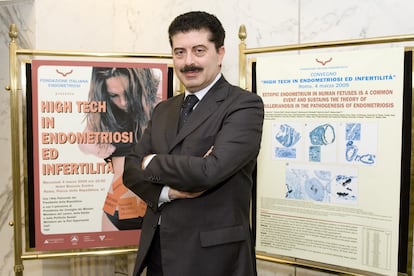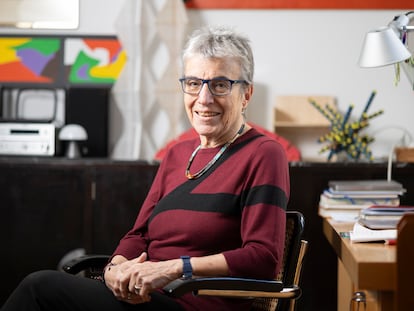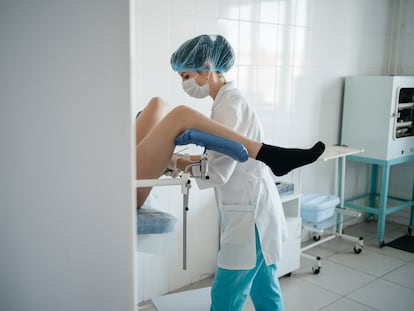Pietro Signorile, gynecologist: ‘Endometriosis is a disease that affects our whole society’
The expert runs Italy’s National Center of Endometriosis, the first of its kind in Europe, which is dedicated to research of the chronic illness

Perhaps you’ve heard of a little-known disease for which the causes are unknown and there is no cure. Or perhaps you haven’t, because almost no one talks about it. It’s called endometriosis, and despite the fact that affects 10% of women worldwide, when Pietro Signorile, 70, an Italian doctor and researcher, did his residency in gynecology, he remembers that only three lines were devoted to the subject in his textbook. “Now there are three pages, which is not nothing, but not enough, either. There should be 30. But first, we have to continue with our research to know what we are talking about,” says the gynecologist, who has spent the last two decades at the helm of the Italian Endometriosis Center, the first of its kind dedicated to research into this mysterious disease. The author of numerous studies and patents aimed at finding a cure for this chronic ailment, Signorile speaks of the importance of having national centers to centralize research, something lacking in the vast majority of countries around the world.
Question. When did you decide to dedicate yourself to studying endometriosis?
Answer. I dedicated the first part of my career to surgical oncology, operating on tumors in the female reproductive system. During those years, I had to perform terrifying, incredibly devastating operations to try to save the lives of my patients. We’re talking 40 years ago, when the systems that are around today did not exist, and this kind of intervention was high risk, caused many complications and did not always have a positive outcome. After a couple of decades working in oncology under these conditions, I began to feel alienated from this kind of pathology. I wanted to make changes and was fascinated by the fact that endometriosis was totally neglected, both by medical school textbooks and physicians, patients, and civil society in general. That continues to be the case.
Q. Why is it so unaddressed?
A. This disease has been penalized for almost 90 years in scientific research because of an incorrect theory by a U.S. colleague, John Sampson. In 1927, he published the theory of retrograde menstruation as the cause of the disease, which stated that retrograde flow of endometrial debris goes backwards through the fallopian tubes during menstruation, into the peritoneal cavity. I have never believed in this theory. I have always fought back against it. But it has prevailed for decades, and has held back research.
Q. Why is that?
A. Because of a series of absurd evidence, which I can understand making sense in the 1920s, but to continue to give it credence in the 21st century — it’s just absurd. Firstly, because retrograde menstruation has been found to affect almost every woman in the world, nearly 90%, while endometriosis affects only 10%. Research has wasted millions over decades, through studies that were supposed to show why the remaining 80% did not suffer from endometriosis, without ever reaching a conclusion, because it was the wrong hypothesis. You can find proof of this in the fact that even women with Rokitansky syndrome, who are born without uterus and fallopian tubes, have endometriosis, and in a higher percentage than other women.
People, and primarily physicians, must understand that this is a real disease, that it’s not made up
Q. There are so many doubts around this disease. Is there anything that we know for sure about it?
A. We are certain that it is a congenital disease. A decade ago, we came to this conclusion through a study on fetuses. Specifically, we based this conclusion on a series of around 101 human female fetuses that died at different times during gestation. We discovered that 10% of these samples had endometrial tissue outside the uterus, which supports the hypothesis that this is a disease that manifests even before birth.
Q. Why is so important for national centers to exist?
A. To centralize research. In addition to our center, we also created the Italian Endometriosis Foundation, which has three objectives: research, patient support and clinical treatment. Although it is not a very large entity, it is a foundation that is dedicated exclusively to this work, which is the only way to go from it being a disease about which practically nothing was known to being able to find a cure. Full-time commitment is needed. What would be interesting would be to have a centralization of research, not only in Italy, but at a more global level, so that it does not take another 50 years before new advances are made.
Q. What is currently the most urgent aspect of this research?
A. Without a doubt, accelerating diagnosis. In European Union countries, it takes approximately seven years to arrive at a diagnosis, and women spend around $7500 each. This can’t be. For each week, month and year that is lost, quality of life for these women plummets dramatically. It’s important to understand that this is not a disease that only impacts women, but rather, our entire society. Patients who suffer from it have up to three times more chances of developing ovarian tumors, and it also elevates the risk of infertility. It is a family disease.
Q. What are you currently working on, in terms of the foundation?
A. We have isolated proteins that are present in the saliva and blood of women with endometriosis, and we have generated a diagnostic test that uses saliva. We are about to initiate the final phase of validation at the Ministry of Health, to be able to implement it. This would drastically reduce waiting times to obtain a diagnosis. We have also managed to improve MRI examinations, because the disease is not always visible if you don’t know exactly where to look. If it is in organs, that is not visible, even with surgery. That is why we have generated a specific contrast agent for endometrial tissue, which allows us to identify all the tissues with MRI, and is giving exceptional results. The next step is to focus on therapy, which is the most important thing for patients.
It takes approximately seven years to arrive at a diagnosis
Q. Oftentimes, patients with endometriosis are prescribed contraceptive pills. Does that work?
A. It works to reduce pain. The problem with the birth control pill is that it contains estrogens, and the disease grows with estrogens, which makes it a very controversial solution, especially if it has to do with long-term treatment. Taking it for a few months is fine.
Q. And surgery? When is that recommended?
A. Surgery has its uncertainties, because the interorgan foci do not appear on the surface of the organs, and are not seen with surgery, which makes them therefore impossible to eliminate. In many cases, surgery, even if it is very radical, does not guarantee that all of the disease is eliminated. Also, you never know if it is fully developed when you do the surgery, and it may be that some cells have yet to grow, and will grow in one, two or five years, which means more operations. It is not an effective treatment, because it has so many limits.
Q. So, what treatment does work?
A. Right now, there is no definitive cure. Finding one is every gynecologist’s dream. We are working on it, and we have already gotten an Italian patent to develop an immunological treatment. We are convinced that this will be the future of the disease. It creates specific antibodies that destroy or block the cells, and possibly modify those found in the uterus. All our physical, intellectual and economic resources have been put into this.
Q. When will it be available?
A. It’s impossible to say with any certainly because research is like walking on rocks, it’s extremely dangerous. It’s a path that is full of roadblocks. We are in the pre-clinical cellular phase, testing what we have produced in endometriosis cells and in a normal endometrium. After this phase, if all goes well, we will have to test in animals, and only then can we move on to humans. In the meantime, we must continue to raise awareness. People, and more than anyone else, doctors, have to understand that this is a real disease, that it is not made up. I have patients who come to us after their gynecologist has told them not to worry, that they have to stay calm, or that their problem is stress-related. It is not.
Q. And in the meantime, what can we do to alleviate everyday pain?
A. One thing that we developed more than 12 years ago, and which works, is an anti-inflammatory diet. The disease creates chronic inflammation, and estrogens are the gasoline that makes endometriosis grow. In addition, it is proven that the more inflammation you have, the more the disease itself produces estrogens, which means it is self-feeding. Our diet calls for a drastic reduction of inflammatory foods such as red meat, dairy and gluten — and an increase in foods that do the opposite: fruit, vegetables, legumes, fish rich in omega 3. By doing this, we get the patient to lower their inflammation and therefore, the production of estrogens, to the point where it slows the growth of the disease.
Sign up for our weekly newsletter to get more English-language news coverage from EL PAÍS USA Edition
Tu suscripción se está usando en otro dispositivo
¿Quieres añadir otro usuario a tu suscripción?
Si continúas leyendo en este dispositivo, no se podrá leer en el otro.
FlechaTu suscripción se está usando en otro dispositivo y solo puedes acceder a EL PAÍS desde un dispositivo a la vez.
Si quieres compartir tu cuenta, cambia tu suscripción a la modalidad Premium, así podrás añadir otro usuario. Cada uno accederá con su propia cuenta de email, lo que os permitirá personalizar vuestra experiencia en EL PAÍS.
¿Tienes una suscripción de empresa? Accede aquí para contratar más cuentas.
En el caso de no saber quién está usando tu cuenta, te recomendamos cambiar tu contraseña aquí.
Si decides continuar compartiendo tu cuenta, este mensaje se mostrará en tu dispositivo y en el de la otra persona que está usando tu cuenta de forma indefinida, afectando a tu experiencia de lectura. Puedes consultar aquí los términos y condiciones de la suscripción digital.
More information
Archived In
Últimas noticias
Most viewed
- Sinaloa Cartel war is taking its toll on Los Chapitos
- Oona Chaplin: ‘I told James Cameron that I was living in a treehouse and starting a permaculture project with a friend’
- Reinhard Genzel, Nobel laureate in physics: ‘One-minute videos will never give you the truth’
- Why the price of coffee has skyrocketed: from Brazilian plantations to specialty coffee houses
- Silver prices are going crazy: This is what’s fueling the rally











































